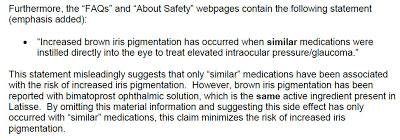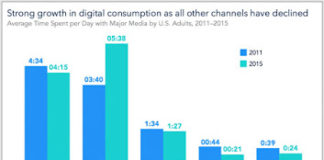On September 10, 2009, the FDA sent Allergan a notice that its Latisse Web site was misleading (see “FDA Says Allergan’s Web Site for Eyelash Thickener Is Misleading“). The letter states:
“the Division of Drug Marketing, Advertising, and Communications (DDMAC) has reviewed the “FAQs” and “About Safety” pages of a consumer website and a “Launch display timeline” (timeline) (APC36ON09) for LatisseTM (bimatoprost ophthalmic solution) 0.03% (Latisse) submitted by Allergan, Inc. (Allergan) under cover of Form FDA-2253. These promotional materials are misleading because they omit and minimize risks associated with Latisse. Thus, the website and timeline misbrand Latisse in violation of the Federal Food, Drug, and Cosmetic Act…” [my emphasis]
Latisse is Allergan’s product approved for hypotrichosis, a term dermatologists use to describe a condition of no hair growth. Allergan markets Latisse for increasing the growth of eyelashes.
In a previous post dated June 1, 2009 — “Will Latisse Turn Brooke Shields’ Blue Eyes Brown?” — I noted that in the “About Safety” page of the Latisse web site, Allergan stated:
“Increased brown iris pigmentation has occurred when similar medications were instilled directly into the eye to treat elevated intraocular pressure/glaucoma. Although iris pigmentation was not reported in clinical studies with LATISSE™, patients should be advised about the potential for increased brown iris pigmentation which is likely to be permanent.”
I commented: When Allergan says “similar medications,” it really should have said “this medication” because Latisse is just another name for Lumigan, Allergan’s anti-glacoma drug. Both are (bimatoprost ophthalmic solution) 0.03%.
FDA, in its letter to Allergan, said (click on image to enlarge and read):
Of course, I conclude from this that FDA reads Pharma Marketing Blog. Maybe it has also read my post about organic search “ads” (see “Are Organic Search Results Next on FDA’s Chopping Block?“).









![6 Digital Tools at the Center of Healthcare Digitalization [INFOGRAPHIC]](http://ec2-54-175-84-28.compute-1.amazonaws.com/pharma-mkting.com/wp-content/uploads/2021/04/6DigitalTools_600px-100x70.jpg)




